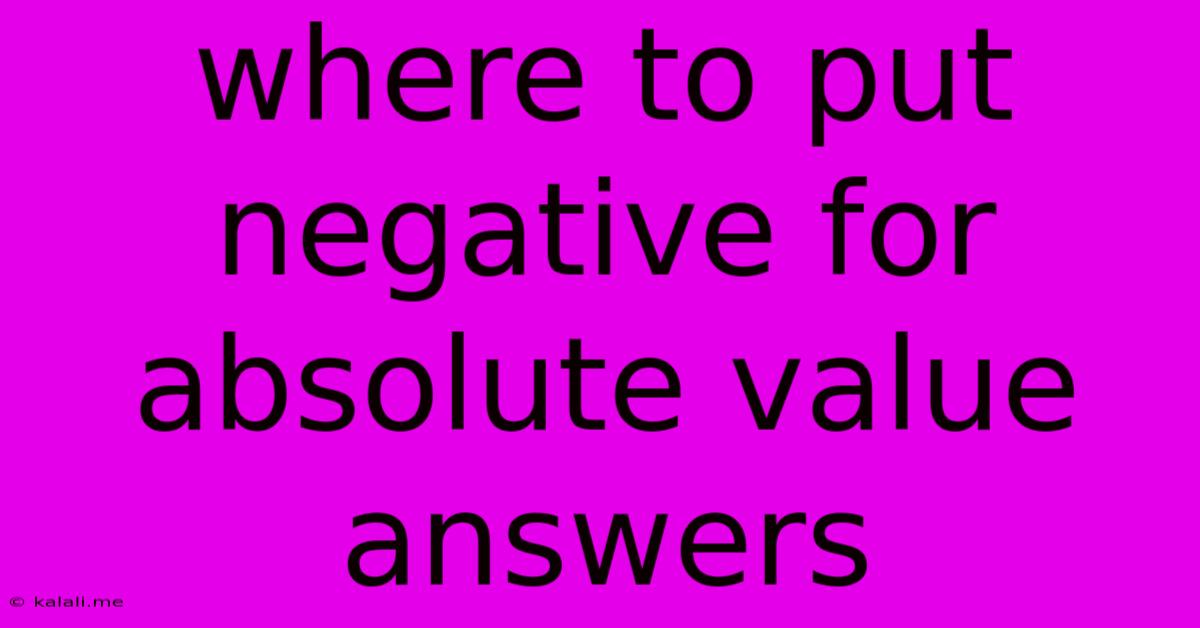Where To Put Negative For Absolute Value Answers
Kalali
Jun 09, 2025 · 3 min read

Table of Contents
Where to Put the Negative for Absolute Value Answers: A Comprehensive Guide
Absolute value, represented by the symbol | |, always results in a non-negative number. It represents the distance a number is from zero on the number line, and distance is always positive or zero. However, solving equations and inequalities involving absolute values often leads to negative solutions within the absolute value bars. Understanding where to place the negative sign to arrive at the correct final answer is crucial. This guide will clarify the process.
Understanding Absolute Value and its Properties
Before diving into the placement of negatives, let's solidify our understanding of absolute value. The absolute value of a number x, denoted as |x|, is defined as:
- |x| = x, if x ≥ 0
- |x| = -x, if x < 0
This means the absolute value of a positive number is the number itself, and the absolute value of a negative number is its positive counterpart. For example:
- |5| = 5
- |-5| = 5
Solving Equations and Inequalities with Absolute Value
When solving equations or inequalities involving absolute value, the key is to consider both the positive and negative cases. This stems from the definition of absolute value. Let's explore some examples:
1. Solving Equations:
Example: |x - 3| = 5
This equation means the distance between x and 3 is 5 units. Therefore, x could be 5 units to the right of 3 (x = 8) or 5 units to the left of 3 (x = -2).
To solve algebraically:
- Case 1 (Positive): x - 3 = 5 => x = 8
- Case 2 (Negative): -(x - 3) = 5 => -x + 3 = 5 => -x = 2 => x = -2
Therefore, the solutions are x = 8 and x = -2. Notice that the negative sign is applied to the entire expression inside the absolute value bars in Case 2.
2. Solving Inequalities:
Solving inequalities involving absolute values requires a slightly different approach.
Example: |x + 2| < 4
This inequality means the distance between x and -2 is less than 4 units. This translates to a compound inequality:
-4 < x + 2 < 4
Subtracting 2 from all parts:
-6 < x < 2
Therefore, the solution is -6 < x < 2. The negative doesn't directly influence the placement of the negative sign; rather, it shapes the compound inequality's structure.
Example: |x - 1| > 3
This means the distance between x and 1 is greater than 3 units. This results in two separate inequalities:
- x - 1 > 3 => x > 4
- -(x - 1) > 3 => -x + 1 > 3 => -x > 2 => x < -2
Therefore, the solution is x > 4 or x < -2. Again, the negative is applied to the entire expression inside the absolute value to create the second inequality.
Common Mistakes to Avoid:
- Applying the negative only to the variable: Remember to apply the negative to the entire expression within the absolute value bars.
- Forgetting the second case: Always consider both the positive and negative cases when solving equations and inequalities involving absolute values.
- Incorrectly handling compound inequalities: Understand the implications of "less than" and "greater than" inequalities within the context of absolute value.
In Conclusion:
The placement of the negative sign when dealing with absolute value problems is not arbitrary. It's crucial to understand the definition of absolute value and systematically address both positive and negative cases to accurately solve equations and inequalities. By carefully applying the negative to the entire expression inside the absolute value, you'll accurately determine the solution set. Remember to practice diligently to master this important concept.
Latest Posts
Latest Posts
-
How Do I Get Stone In Minecraft
Jun 09, 2025
-
How Long To Wait Before Staining Treated Lumber
Jun 09, 2025
-
What To Do When The Turkey Is Done Early
Jun 09, 2025
-
What Can You Substitute For Sesame Oil
Jun 09, 2025
-
What Kind Of Oil Does Subway Use
Jun 09, 2025
Related Post
Thank you for visiting our website which covers about Where To Put Negative For Absolute Value Answers . We hope the information provided has been useful to you. Feel free to contact us if you have any questions or need further assistance. See you next time and don't miss to bookmark.